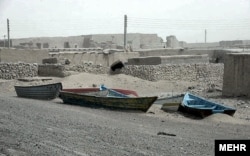Water has exposed cracks in the Taliban's fragile relationship with Tehran, with both sides exchanging pointed barbs over scarce supplies before coming to deadly blows along the Afghan-Iranian border.
Tensions remain high following the deaths of troops from both sides on May 27, with Taliban and Iranian officials digging in on their positions with increased military activity and fresh warnings.
But while disputes over water security are expected to intensify between the two drought-stricken countries, both sides appear to be keeping the door open for dialogue on the issue while boosting cooperation in other areas of mutual concern.
The deadly firefight took place across the shared border between southeastern Iran and southwestern Afghanistan, with each side accusing the other of firing first. Social media footage showed Taliban heavy weaponry streaming to the border in the Kang district of Nimroz Province, where officials said one Taliban border guard was killed and several people were wounded after an exchange of heavy gunfire.
Iranian media, meanwhile, said up to three Iranian border guards were killed and several people wounded in its southeastern Sistan-Baluchistan Province, where Iran has worked to fortify its border as tensions over water supplies rose over the past two weeks.
Following the incident, the Taliban has continued to push back on Iran's claim that it is not honoring a water treaty ironed out by the two sides in 1973.
"The Islamic Emirate of Afghanistan considers dialogue to be a reasonable way for any problem," Taliban Defense Ministry spokesman Enayatullah Khawarazmi said in a statement on May 28, referring to the official name of the Taliban's unrecognized government. "Making excuses for war and negative actions is not in the interest of any of the parties."
Iran has continued its harder line, with national police commander Brigadier-General Ahmadreza Radan saying the same day that "the border forces of the Islamic republic of Iran will decisively respond to any border trespassing and aggression, and the current authorities of Afghanistan must be held accountable for their unmeasured and contrary actions to international principles."
But Iranian officials, too, have expressed the need for a diplomatic solution, with high-ranking security official Mohammad Ismail Kothari describing the dispute as "fighting between children of the same house" while rejecting that Tehran would resort to the "military option."
Big Dam Issues
Water is a precious commodity in both southwestern Afghanistan, one of the country's most productive agricultural areas, and in southeastern Iran, one of several arid areas of the country where water scarcity has fueled public protests.
But with Afghanistan in control of upriver water sources that feed low-lying wetlands and lakes in Iran's southeast, the Taliban finds itself with a rare tool for leverage in its relationship with Tehran.
The problem -- or the solution, depending on which side you consider -- stems from the construction of major dam projects in Afghanistan that in combination with increased drought and other factors have restricted the flow of water to the Sistan Basin.
The border-straddling basin depends on perennial flooding to fill what used to be a vast wildlife oasis and was home to the massive Hamun Lake, which now consists of three smaller seasonal lakes -- Hamun-e Helmand in Iran and Hamun-e Sabari and Hamun-e Puzak in both Afghanistan and Iran.
The longstanding issue of replenishing the basin with water came to the forefront earlier this month following comments by Iranian Foreign Minister Hossein Amir-Abdollahian and President Ebrahim Raisi.
Amir-Abdollahian, in a call with his Taliban counterpart, Amir Khan Muttaqi, demanded the Afghan authorities open the gates of the inland Kajaki Dam that pools water from the Helmand River "so both the people of Afghanistan and Iran can be hydrated."
Shortly afterward, Raisi upped the ante during a visit to Sistan-Baluchistan on May 18 by warning the "rulers of Afghanistan to immediately give the people of Sistan-Baluchistan their water rights." He added that the Taliban should take his words "seriously" and not say "they were not told."
The Taliban has consistently denied the accusation that it was not complying with the 1973 treaty and said that even if the Kajaki Dam were opened there would not be enough water to reach Iran.
But just two days after Raisi's threats, the Taliban appeared to twist the knife by inaugurating a new irrigation project that involved completing the construction of the Bakhshabad Dam on the Farah River, which feeds the Sistan Basin from the north.
Contentious Water Treaty
According to the 1973 treaty, Afghanistan is committed to sharing water from the Helmand River with Iran at the rate of 26 cubic meters of water per second, or 850 million cubic meters per year.
But the accord also allows for less water to be delivered in cases of low water levels, which have been affected by persistent drought and the construction of new dams in Afghanistan, including the Kamal Khan Dam on the Helmand River that was completed in 2021 shortly before the Taliban seized power in Kabul.
The Taliban's deputy prime minister for economic affairs, Mullah Abdul Ghani Baradar, said on May 22 that Kabul was "committed to the water treaty of 1973 but the drought that exists in Afghanistan and region should not be ignored."
"The pain of the people of Sistan-Baluchistan is our pain," he added. "Our hearts melt for them as much as they melt for the people of Afghanistan, but we also suffer from a shortage of water."
Cooperation on the water issue was previously seen as a sign of deepening ties between Afghanistan's Sunni Taliban rulers and Shi'a-majority Iran. In January 2022, the Taliban released water from the Kamal Khan Dam on the Helmand River in Nimroz Province into the Hamun Lake.
While their sectarian differences once made them enemies, their common interests in opposing Afghanistan's Western-backed government and U.S.-led forces in Afghanistan over the past two decades brought them closer.
Since the Taliban returned to power, the militant group has sought to build economic and security ties with Tehran. While Iran has not recognized the Taliban-led government, it has sought to work with the group on the issues of Afghan refugees in Iran and cross-border drug trafficking. In February, Iran formally handed over the Afghan Embassy in Tehran to the Taliban.
Afghanistan's and Iran's water crises require both countries to show a strong hand on the issue of water supplies, both for domestic consumption and to protect their national interests. But experts suggest the benefits of cooperation outweigh an escalation of the conflict.
"Neither country at this point in time needs a really hostile border," Marvin Weinbaum, director of Afghanistan and Pakistan studies at the Middle East Institute think tank in Washington, told RFE/RL.
"Economically it is an issue for both countries -- there would be no agricultural potential in Helmand Province without the water furnished by the dam. And very little of it gets into Iran. And southeast Iran is as dry as any place on the planet."
Weinbaum said neither the Taliban nor Tehran is going to exhibit weakness on the issue of short-term water shortages. "As the climate heats up, this is only going to grow more acute," he said.
But for both countries, Weinbaum said, "economic ties are really what matters the most," along with cooperating on other issues of mutual concern such as preventing the Islamic State extremist group from expanding its foothold in the region.
Ironically, just days after Raisi's threats and the inauguration of a new dam project in Afghanistan, the Taliban's Defense Ministry announced it had reached a new agreement on cooperating with Iran on defense and border issues. And on the day of the firefight that left border guards dead on both sides, officials had met earlier to discuss the water dispute.
After the deadly incident, Iranian and Taliban officials held another meeting to investigate the cause of the "tensions."
Path To Resolution
The construction of dams -- which both Iran and Afghanistan engage heavily in -- and their downstream impact stand out among the causes to discuss.
"What really triggers these disputes?" asked Weinbaum. "The intensification of them is obviously building dams, which represent simply a lower flow than they've been accustomed to and are not happy with."
Other observers suggest the decades-old water-sharing agreement that Iran and the Taliban accuse each other of failing to adhere to holds the answer to resolving the dispute.
The 1973 treaty does allow for the delivery of water from the Afghan side to be lower than the agreed-upon levels under certain circumstances, which would appear to include the drought and climate change that the Taliban has said have limited water supplies.
It also commits the two countries to follow a set course "in the event that a difference should develop in the interpretation" of the provisions set out in the treaty: diplomatic negotiations, turning to the "good offices" of a third party to help mediate a solution, and in the event neither step works, arbitration.




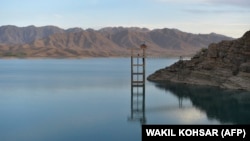

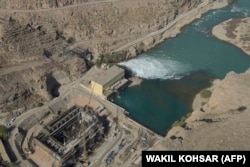
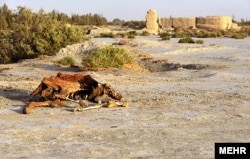
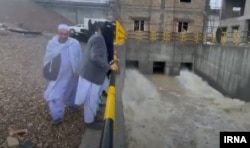
!["In the subway, you need to pay with a bank card. They don't accept cash," an Afghan said.. "Some [Iranians] buy tickets for us [in exchange for cash], but others don't."](https://gdb.rferl.org/d3d69280-6188-422c-bb80-06aa4ca94f3a_cx0_cy6_cw0_w100_r1.jpg)
